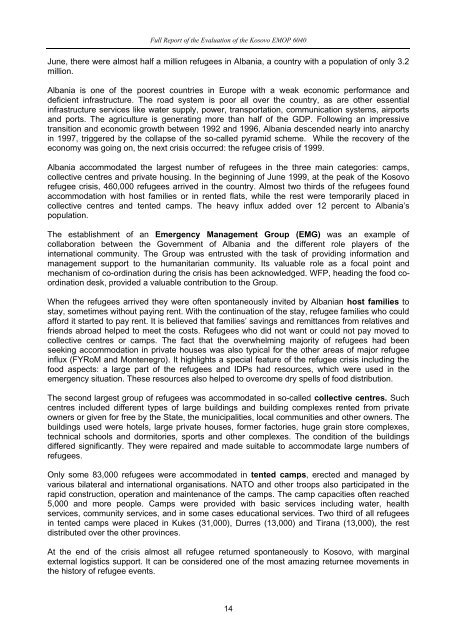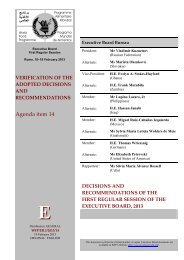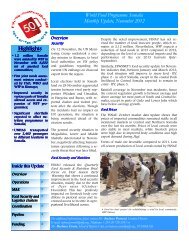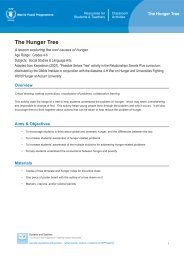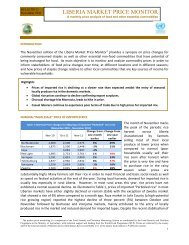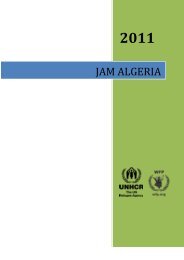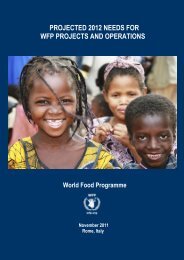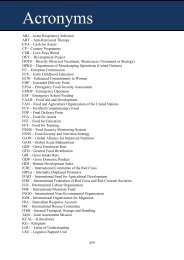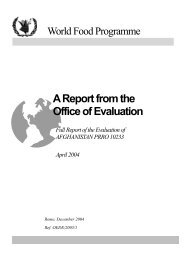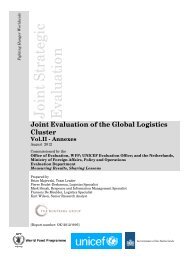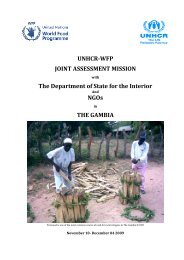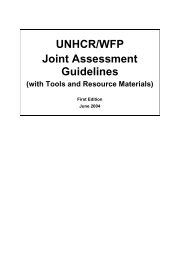Full Report - WFP Remote Access Secure Services
Full Report - WFP Remote Access Secure Services
Full Report - WFP Remote Access Secure Services
Create successful ePaper yourself
Turn your PDF publications into a flip-book with our unique Google optimized e-Paper software.
<strong>Full</strong> <strong>Report</strong> of the Evaluation of the Kosovo EMOP 6040<br />
June, there were almost half a million refugees in Albania, a country with a population of only 3.2<br />
million.<br />
Albania is one of the poorest countries in Europe with a weak economic performance and<br />
deficient infrastructure. The road system is poor all over the country, as are other essential<br />
infrastructure services like water supply, power, transportation, communication systems, airports<br />
and ports. The agriculture is generating more than half of the GDP. Following an impressive<br />
transition and economic growth between 1992 and 1996, Albania descended nearly into anarchy<br />
in 1997, triggered by the collapse of the so-called pyramid scheme. While the recovery of the<br />
economy was going on, the next crisis occurred: the refugee crisis of 1999.<br />
Albania accommodated the largest number of refugees in the three main categories: camps,<br />
collective centres and private housing. In the beginning of June 1999, at the peak of the Kosovo<br />
refugee crisis, 460,000 refugees arrived in the country. Almost two thirds of the refugees found<br />
accommodation with host families or in rented flats, while the rest were temporarily placed in<br />
collective centres and tented camps. The heavy influx added over 12 percent to Albania’s<br />
population.<br />
The establishment of an Emergency Management Group (EMG) was an example of<br />
collaboration between the Government of Albania and the different role players of the<br />
international community. The Group was entrusted with the task of providing information and<br />
management support to the humanitarian community. Its valuable role as a focal point and<br />
mechanism of co-ordination during the crisis has been acknowledged. <strong>WFP</strong>, heading the food coordination<br />
desk, provided a valuable contribution to the Group.<br />
When the refugees arrived they were often spontaneously invited by Albanian host families to<br />
stay, sometimes without paying rent. With the continuation of the stay, refugee families who could<br />
afford it started to pay rent. It is believed that families’ savings and remittances from relatives and<br />
friends abroad helped to meet the costs. Refugees who did not want or could not pay moved to<br />
collective centres or camps. The fact that the overwhelming majority of refugees had been<br />
seeking accommodation in private houses was also typical for the other areas of major refugee<br />
influx (FYRoM and Montenegro). It highlights a special feature of the refugee crisis including the<br />
food aspects: a large part of the refugees and IDPs had resources, which were used in the<br />
emergency situation. These resources also helped to overcome dry spells of food distribution.<br />
The second largest group of refugees was accommodated in so-called collective centres. Such<br />
centres included different types of large buildings and building complexes rented from private<br />
owners or given for free by the State, the municipalities, local communities and other owners. The<br />
buildings used were hotels, large private houses, former factories, huge grain store complexes,<br />
technical schools and dormitories, sports and other complexes. The condition of the buildings<br />
differed significantly. They were repaired and made suitable to accommodate large numbers of<br />
refugees.<br />
Only some 83,000 refugees were accommodated in tented camps, erected and managed by<br />
various bilateral and international organisations. NATO and other troops also participated in the<br />
rapid construction, operation and maintenance of the camps. The camp capacities often reached<br />
5,000 and more people. Camps were provided with basic services including water, health<br />
services, community services, and in some cases educational services. Two third of all refugees<br />
in tented camps were placed in Kukes (31,000), Durres (13,000) and Tirana (13,000), the rest<br />
distributed over the other provinces.<br />
At the end of the crisis almost all refugee returned spontaneously to Kosovo, with marginal<br />
external logistics support. It can be considered one of the most amazing returnee movements in<br />
the history of refugee events.<br />
14


